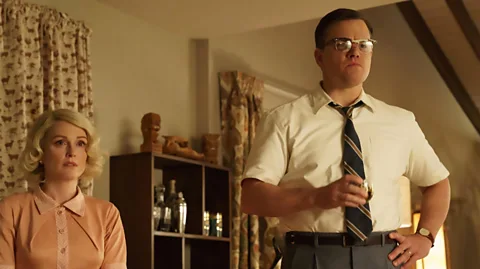Film review: George Clooney’s Suburbicon
 Paramount Pictures
Paramount PicturesGeorge Clooney’s new film is a collaboration with the Coen brothers that is set in 1959 but ‘sickeningly pertinent to 2017’, writes Nicholas Barber.
The delicious new pastel-coloured Hitchcock homage directed by George Clooney – and co-written by Clooney, Grant Heslov, and the Coen brothers – is set in 1959, but it is sickeningly pertinent to 2017. Alongside Detroit and Bushwick, Suburbicon is one of several current films that were in production well before the Trump presidency, but which could have been made specifically in response to the Charlottesville rally.
The upbeat opening sequence is an animated brochure advertising Suburbicon, a gleaming new town comprising thousands of rows of identical bungalows. This Stepford-ish community is a “melting pot of diversity”, oozes a voice-over, in the sense that clean-cut, white families have moved there from all over the US. But then comes an exquisite skit in which a jolly neighbourhood postman visits a family that has just arrived in the area. “Is Mrs Meyers in?,” he asks the black woman who comes to the door. When she (Karimah Westbrook) replies that she is Mrs Meyers, the postman’s pained grimace promises that we’re in for a race-relations satire to savour.
A few scenes later, however, Suburbicon turns its attention to the Meyers’ neighbours, Gardner (a bespectacled, unsmiling Matt Damon), his wife Rose and his sister-in-law Maggie (both played by Julianne Moore), and his lonely son Nicky (Noah Jupe). Like everyone else in the town, they seem to believe that the place is as goshdarned free of crime as it is of communist sympathisers, but they have a rude awakening one night when two thugs break in and tie them to their spotless kitchen chairs. And the family’s troubles don’t end there. Gardner knows more about the thugs than he has told his wife, and so, having twanged our nerves with a pitiless home-invasion scene, Suburbicon becomes a macabre farce with too many noirish twists, revelations and gruesome murders to count.
A draft of the screenplay was written by the Coens 30 years ago, and its ingredients have been stirred into their films ever since - Fargo in particular. There are temptresses and blackmailers, there are sharp-eyed detectives and bumbling but vicious mobsters, and there are superficially respectable men who are pushed by their financial worries towards some not-so-respectable deeds. It’s fizzingly entertaining. Clooney and his team revel in their pastiche of the all-American 1950s lifestyle that still obsesses certain US citizens, and the actors revel in their roles. Damon paints his white-collar, white-bread breadwinner with subtly darker shades as the film goes on; Moore shines as a desperate housewife with the hairdo and the breathy coo of Marilyn Monroe; and Oscar Isaacs practically dances through his virtuoso cameo as a cocky insurance claims investigator.
But if Suburbicon is more enjoyable than most films, it’s not a complete success. Partly, that’s because the Coen brothers have made so many comparable comedy-thrillers since they wrote the screenplay that it all seems quite familiar: it’s like watching a tribute band playing polished cover versions of your favourite band’s greatest hits. But a bigger issue is that the Meyers are pushed to one side.
While Gardner is sinking ever deeper into a swamp of debt and danger, his new neighbours are being terrorised in scenes inspired by the harassment of the Myers family in Levittown, Pennsylvania in 1957. First people erect a high wooden fence around their property. Then they lean over that fence, shouting and banging drums, day and night. But, of course, none of these persecutors would it to being racist. It’s just that they “demand our civil rights to live where we like and with whom we like”. See what I mean about it being sickeningly pertinent?
Lodge is oblivious to what the Meyers are going through - and that, I assume, is the point. While the newcomers are quietly and bravely enduring a nightmarish ordeal, the supposedly wholesome folks next door can think only of the troubles they have brought upon themselves. The entire film, then, is a joke about blinkered white privilege: it’s surely no accident that Mr Meyers isn’t given a single line of dialogue. But, as crafty as Clooney’s ironic tactics may be, it still feels as if he is telling the wrong story. Maybe at some other time we could have luxuriated in the Coens’ underworld high jinx, and we could have ired the pointed conceit of the black characters being under-used. But with everything that is happening in America at the moment, it would have been better if the Meyers had had their own film, rather than being stuck in a subplot of someone else’s.
★★★★☆
If you would like to comment on this story or anything else you have seen on BBC Culture, head over to our Facebook page or message us on Twitter.
And if you liked this story, sign up for the weekly bbc.com features newsletter, called “If You Only Read 6 Things This Week”. A handpicked selection of stories from BBC Future, Earth, Culture, Capital and Travel, delivered to your inbox every Friday.
